
Solo mining can be a bit of a lonely grind, and let’s face it, scoring rewards this way (especially with Bitcoin) has become tough. Luckily, you can join a mining pool that brings more steady and predictable rewards. Speaking of which, in this EMCD review, I’ll introduce you to a platform that provides great mining pools, amongst other things.
While I’ll get into more detail later, note that this isn’t just another EMCD pool review. We’re going to explore the entire ecosystem, and trust me, there’s a lot it has to offer. That said, let’s get to it!
Verdict at a glance: EMCD is a platform that started out with a sole focus on crypto mining but later expanded and incorporated more features, such as the EMCD Wallet, P2P trading, and Coinhold. EMCD boasts a user-friendly interface and some of the most competitive fees on the market. Though, when it comes to its mining pools, they do have comparatively low hashrates.
Free Airdrop Season 7 is LIVE! Answer fun questions or do simple tasks to earn rewards from the $30K BitDegree prize pool. Participate Now ! 🔥
Pros
- Various mining pools
- Fee-free withdrawals
- P2P trading
- Strong security measures
- Savings accounts with up to 14% APY
Cons
- Comparatively low hashrate
Table of Contents
- 1. What is EMCD?
- 2. EMCD Review: PROS
- 2.1. 5 Pillar Security Approach
- 2.2. Mining With Daily Payouts
- 2.3. Fee-Free Withdrawals from the EMCD Wallet
- 2.4. Earn Up to 14% APY With Coinhold
- 2.5. P2P Trading With Zero Fees
- 3. EMCD Review: CONS
- 3.1. Comparatively Low Hash Power
- 4. EMCD Fees
- 5. How to Use EMCD?
- 5.1. How to Start Mining on EMCD?
- 5.2. How to Use Coinhold?
- 6. Conclusions
What is EMCD?
Let’s start off this EMCD review by understanding the platform's purpose. It was established in 2017 with the launch of the EMCD mining pool. So, initially, the platform was only about mining.
While its focus didn’t stray away from that, by 2022, EMCD had developed quite a unique and extensive ecosystem that encompasses features for mining, storing, trading, *and* growing crypto.
These features include the EMCD Wallet, Coinhold, and P2P trading. Nonetheless, as of writing, the EMCD.io pool is the largest Bitcoin mining pool in Eastern Europe and one of the top 7 mining pools in the world. That said, let’s explore its features in more detail.
EMCD Review: PROS
While going through user EMCD reviews online, I noticed that the overall sentiment toward the platform is strongly positive. After checking out EMCD myself, I can say that there are quite a few reasons for that.
5 Pillar Security Approach
For starters, EMCD seems to take user information protection and asset security very seriously. The platform uses a holistic 5 pillar security approach: identify, protect, detect, respond, and recover. So, basically, the EMCD team is keen on detecting issues before they happen and finding immediate solutions.
There is even a Cyber Security Incident Response Team (CSIRT) on stand-by, and the Security Incident Response Management Plan (SIRMP) is set in place to react promptly if anything happens.
It’s also worth noting that EMCD complies with KYC/AML regulations and continuously monitors user transactions for any suspicious activity. However, it is aligned with ISO 27000 standards and acts in accordance with various regulations and policies that ensure confidentiality and integrity, so users don’t have to worry about the security of their information.

When it comes to asset management, all user assets are classified and managed carefully to ensure the highest protection. Also, EMCD claims to use top-tier encryption for its hard drives and devices *and* it employs the TLS protocol with encryption algorithms.
On top of all that, the entire EMCD crypto ecosystem is constantly monitored via thorough software security checks. Plus, any external services provided by the platform undergo detailed security and privacy evaluations.
I know I’ve used a lot of fancy words, but the bottom line is that the EMCD team seems to be putting a lot of effort into securing both your assets and your personal information.
Mining With Daily Payouts
Now, let’s talk about the foundation of the platform – the EMCD mining pool (or, more specifically, pools). What makes them some of the most popular pools worldwide?
For starters, EMCD mining pools have servers located in three different regions: North America, Europe, and Asia.
Moreover, EMCD supports multiple currencies. Unlike some mining platforms that are only focused on providing coin-specific mining services, EMCD seeks to create a broader and more versatile user base. Just note that EMCD does not allow crypto mining using a phone.
As of writing, there are seven EMCD pools, including Bitcoin (BTC), Bitcoin Cash (BCH), Dash (DASH), Dogecoin (DOGE), Ethereum Classic (ETC), Litecoin (LTC), and Kaspa (KAS). Plus, EMCD supports merged mining that allows you to mine Litecoin paired with Dogecoin. This eliminates the need to split the hashrate between mining multiple crypto assets.
When it comes to reward models, EMCD mining pools support different models for different assets, namely:
- Full Pay Per Share (FPPS): for BTC and BCH;
- Pay Per Share + (PPS+): for DASH and LTC;
- Pay-Per-Last-N-Shares (PPLNS): for DOGE, ETC, and KAS.
How do these reward models differ?
FPPS provides stable, fixed payments for each share plus transaction fees, making it the best option for consistent earnings. PPS+ offers slightly more variable but potentially higher payouts by separately rewarding shares and transaction fees. PPLNS, on the other hand, rewards miners based on recent shares only when a block is found, leading to higher but more unpredictable earnings.
Rewards payouts are made daily around 16:00-17:00 (GMT +3), which is a point that is praised in several user EMCD pool reviews. However, note that each currency has a set minimum payout. For example, the minimum payout for Bitcoin is 0.001 BTC, while the minimum payout for Dogecoin is 1 DOGE.
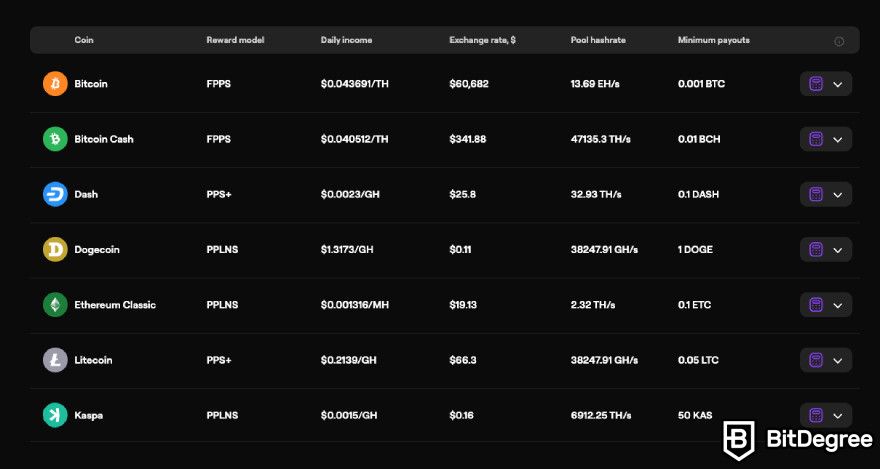
As for fees, the pool fee usually starts at 1.5% but can go up to 4%. Nonetheless, EMCD.io pools surely offer some competitive commission rates. Besides, there is even the option to negotiate VIP conditions for miners with high hashrate. However, you need to contact EMCD to learn more about that.
So, to sum it all up, EMCD pools have wide geographical coverage, support the mining of a decent number of crypto assets, offer several reward models with daily payouts, *and* have some of the lowest commissions. No wonder they’re among the top mining pools worldwide.
Though, that’s not all when it comes to its mining-related services. There are some extra mining-related services praised in many user EMCD reviews.
For example, there is the EMCD Telegram bot, which is a tool that sends you notifications about your mining activities directly through Telegram. By linking the bot to your EMCD crypto account, you can get alerts about worker disconnections, connections, and mining statistics. It’s great for monitoring your mining operations in real time.

Don’t use Telegram? There is also the Watcher-link service, which allows you to monitor the statistics of all your mining workers online. By using an API key obtained from the "Settings" section of your EMCD account, you can access detailed, real-time data about your mining operations through the Watcher-link page on the EMCD website.
In addition to that, EMCD also offers exclusive firmware services from Vnish, providing miners with custom software that can be installed on Antminer mining hardware devices.
The firmware offered by EMCD is designed to enhance the performance of the mining equipment by optimizing power consumption, improving stability, enabling overclocking (to increase hashrate), and adding security features like antivirus protection.
So, these are just a few more reasons why the majority of user EMCD pool reviews are strongly positive. Though, like I mentioned earlier, the mining pools are not the only service offered by EMCD.
Latest Binance Coupon Found:Sign up on Binance and claim up to $600 worth of rewards for completing simple tasks. Use Binance referral code (49316610) to activate the offer while it's still valid!
Fee-Free Withdrawals from the EMCD Wallet
Apart from mining, the platform also provides crypto storing and earning services via the EMCD Wallet. You can access it basically from any device, as the EMCD app can be downloaded using both - Apple Store and Google Store.
When it comes to crypto asset support, the EMCD Wallet allows you to access, store, and send BTC, BCH, LTC, ETH, ETC, DASH, USDT, USDC, DOGE, TON, AVAX, MATIC, KAS, and NOT.
While this might not be the biggest number of cryptocurrencies, the highlight of the wallet is its fee-free Bitcoin, Bitcoin Cash, and Litecoin withdrawals. Just note that these withdrawals are completed within 24 hours; if you want to speed up the process, you’ll have to pay a small fee (but more on that later in this EMCD review).
Also, using the built-in exchanger, you can quickly exchange your crypto assets for fiat currencies, easily pulling them out straight into Visa or Mastercard.

Speaking of withdrawals, you can also set automatic mining withdrawals. In other words, you can “mine” directly into your EMCD Wallet, so you immediately receive funds after accruals. Thus, you won’t have to wait for the standard payout time.
That’s not all, though. Apart from crypto storing and transacting, the wallet has several other useful perks. For one, you can use Hedge, which is a risk management tool that helps to protect your funds from unexpected market changes.
Plus, there is also the Coinhold feature that is closely related to the EMCD wallet, but I’ll talk about it in more detail in the next subchapter. However, simply put, Coinhold is like a crypto savings account.

Now, while all that sounds very nice and convenient, it’s always important to consider security measures, especially when your funds are at stake. As I’ve already discussed in my EMCD review, the platform in question does take security very seriously. This is also true when it comes to the EMCD crypto wallet.
For one, it requires users to create complicated passwords and set mandatory two-factor authentication (2FA). Besides, your funds are distributed on both hot and cold wallets for added security. However, only you have access to your funds, which makes it a non-custodial wallet.
So, overall, the EMCD crypto wallet is not only about storing or transacting crypto assets but also about growing them. Speaking of which, let’s explore Coinhold.
Earn Up to 14% APY With Coinhold
As I touched on earlier in my EMCD review, Coinhold is a crypto savings account that allows you to earn interest on your crypto holdings. Just note that it’s not attributed to banking services.
Now, Coinhold enables you to store and grow BTC, LTC, BCH, ETC, USDT, and USDC. The annual returns can reach up to 8% (for BTC, LTC, BCH, and ETC) and up to 14% (for USDT and USDC). Interest is calculated daily and paid out every 30 days.
Coinhold offers two types of interest rates: fixed and flexible. Fixed APY provides a higher rate but doesn't allow for early withdrawals or partial withdrawals, whereas flexible APY offers the ability to withdraw funds early or partially but with a lower interest rate. Any withdrawal or closure requests are processed over a 24-hour period during which the withdrawal amount is frozen.
Based on the assets in question and the flexibility you choose, there are four types of EMCD Coinhold accounts:
- Coinhold account for BTC, LTC, BCH, and ETC without partial withdrawal - from 6% to 8% possible APY.
- Coinhold account for BTC, LTC, BCH, and ETC with partial withdrawal - from 3% to 6% possible APY.
- Coinhold account for USDT and USDC without partial withdrawal - from 8% to 14% possible APY.
- Coinhold account for USDT and USDC with partial withdrawal - from 5% to 10% possible APY.
It's important to note that to start earning interest, your Coinhold balance must remain unchanged for 24 hours after any deposit or withdrawal. Additionally, for stablecoins like USDT and USDC, a minimum balance of 100 tokens must be maintained.

However, there is no limit for mining coins, and you can even configure a daily automated deduction from your mining account to Coinhold. You can choose from 1% to 100% of your daily mining rewards to be sent straight to Coinhold.
One of the standout features of Coinhold is its transparency and low risk. The funds deposited into Coinhold are used as liquidity for internal exchanges within the EMCD ecosystem rather than being invested in high-risk external platforms.
This approach ensures the security of your assets, with EMCD utilizing distributed storage and custodian services to safeguard funds. Moreover, there are no fees for transfers between your EMCD wallet and your Coinhold account.
All in all, Coinhold is a feature that makes your crypto work for you; you just put the assets you hold into these saving accounts and leave them be.
P2P Trading With Zero Fees
We’ve discussed quite a lot of the platform’s features so far in this EMCD review, but there’s one more that shouldn’t be left out - the EMCD P2P trading service. As of writing, the platform supports 90 fiat-crypto pairs.
It’s a service that allows you to directly exchange cryptocurrencies for fiat money without the need for intermediaries like banks. This decentralized exchange model gives you full control over your transactions, enabling you to set your own terms and choose from a variety of payment methods.
P2P trading involves two main parties: the buyer, who purchases cryptocurrency, and the seller, who offers it for sale. EMCD allows users to create offers to buy or sell cryptocurrency, specifying the amount, price, and preferred payment methods. Once an offer is accepted by the other party, the transaction is completed directly between the buyer and seller.
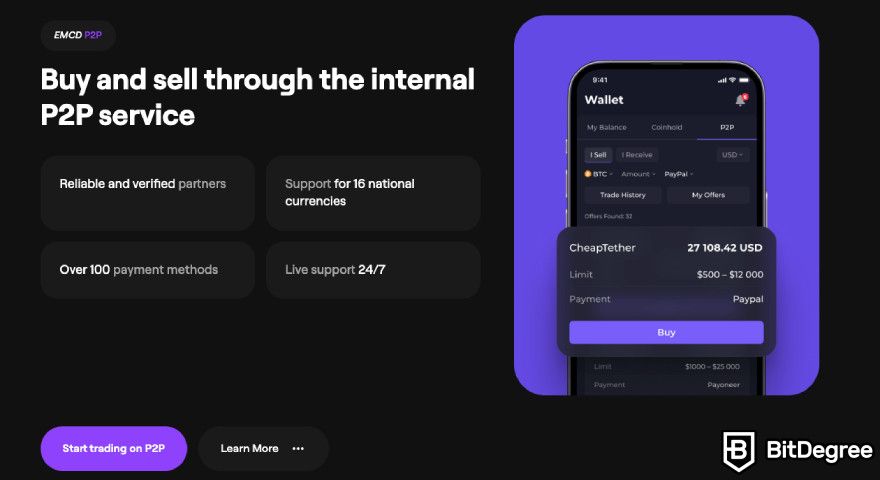
In cases where there is a disagreement between the buyer and seller, a "Dispute" can be opened. This allows the platform to step in and help resolve any issues, ensuring a fair and secure trading environment.
The EMCD P2P platform supports a decent range of cryptocurrencies, including BTC, BCH, ETH, LTC, USDT, and USDC. As of writing, you can trade these cryptocurrencies for a variety of fiat currencies, including USD, EUR, IDR, CNY, AED, VND and ten others.
When it comes to payment methods, sellers can either choose to accept credit/debit card payments, bank transfers, SBP, or Raiffeisenbank. Sellers can specify up to five different payment methods in a single offer.
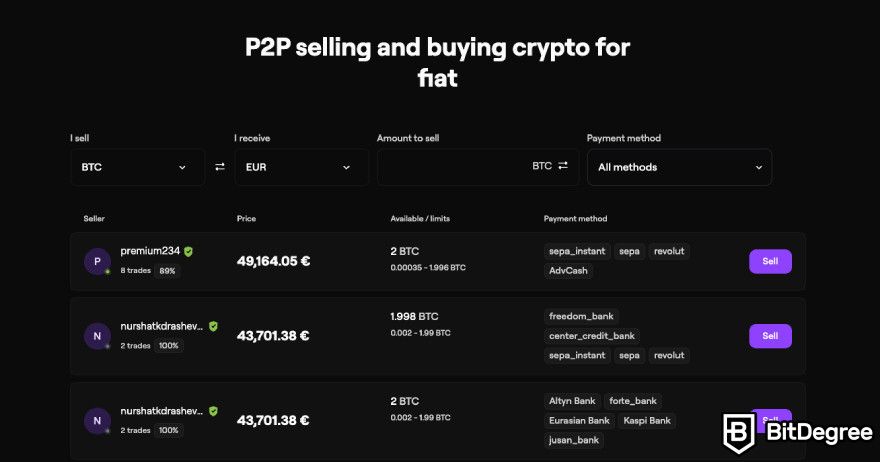
To use the P2P service, users need to log into their EMCD account, top up their wallet with the cryptocurrency they wish to sell, or browse existing offers if they are looking to buy. The platform provides a simple and intuitive interface for creating and managing offers, making it accessible to both new and experienced traders.
It’s also worth noting the unique feature of EMCD P2P trading called "Inactive Mode". This feature lets users set specific hours during which their offers will automatically be unpublished, preventing accidental trades during times when they are not active. Users can easily republish their offers when they are ready to resume trading.
Overall, the P2P service on EMCD provides a flexible and secure way to exchange cryptocurrencies for fiat money, with features designed to accommodate different trading styles and preferences.

Did you know?
All Crypto Exchanges may look similar to you but they're NOT all the same!
EMCD Review: CONS
Now that we went over all the pros of the platform, we should also look at the cons. Truthfully, though, I didn’t notice many cons myself, nor did I see any serious ones mentioned in other user EMCD reviews. The main thing I did notice is that EMCD mining pools do have relatively low hashrates.
Comparatively Low Hash Power
As of writing, the EMCD Bitcoin pool, for example, has a hashrate of 14.09 EH/s, whereas other major pools typically exceed 20 or even 30 EH/s. While this might seem like a slight disadvantage, it’s important to understand that the actual pool hashrate can differ from the reported hashrate based on your mining equipment and its efficiency[1].
Besides, the EMCD team makes significant strides in improving their mining pool's performance. As their team expands, so does the hashrate and profitability of the EMCD.io pool. This growth reflects EMCD's commitment to enhancing its mining infrastructure, even if its hashrate currently lags behind some of the larger pools.
In the end, while the lower hashrate might be seen as a minor con, EMCD’s dedication to maintaining high standards of quality and integrity makes it a reliable choice for miners.
EMCD Fees
While I’ve already talked a bit about the platform’s fees in this EMCD review, let me put all the necessary information in one place.
So, for one, there is the EMCD mining pool fee. The default pool commission on all coins is 1.5% (but it could go up to 4% depending on EMCD partners’ conditions). Also, you don’t have to pay transaction fees during payouts, because they are paid by the pool.
Overall, when it comes to mining pool fees, EMCD surely offers some of the most competitive rates on the market.
Now, getting back to the EMCD wallet, as you already know, you can make fee-free BTC, BCH, and LTC withdrawals to external wallets. However, such withdrawals do take 24 hours. To make them quicker, you have to pay a small fee. Here are all the crypto withdrawal fees charged by the platform:
| Coin | Withdrawal Fee | Withdrawal Time |
| Bitcoin | 0.0005 BTC | 60 minutes |
| Bitcoin Cash | 0.001 BCH | 60 minutes |
| Litecoin | 0.0017 LTC | 60 minutes |
| Tether | $1 | 5 minutes |
| USD Coin | $1 | 5 minutes |
Table: Crypto withdrawal fees via the EMCD crypto wallet.
Talking about other platform products, such as EMCD P2P trading or Coinhold, there are no fees associated with them. Therefore, it’s pretty clear that EMCD is a great platform if you’re not a fan of high fees (who is, right?).
How to Use EMCD?
So far in my EMCD review, I've covered the major pros and cons of the platform. Now, let's dive into something more practical and find out how user-friendly (or challenging) it is when it comes to navigation.
How to Start Mining on EMCD?
Let’s start with the main product of EMCD - its mining pools. I can immediately tell you that as far as mining pools go, the one in question does offer a beginner-friendly interface, which is also noted in several user EMCD pool reviews.
In this guide, I’ll specifically go over the process of Bitcoin mining, but you can find more guides with other currencies on EMCD.
Step 1: Choose the right equipment.
Do note that Bitcoin can only be mined using devices that support the SHA-256 algorithm. ASIC devices are the most efficient and commonly used for Bitcoin mining[2].
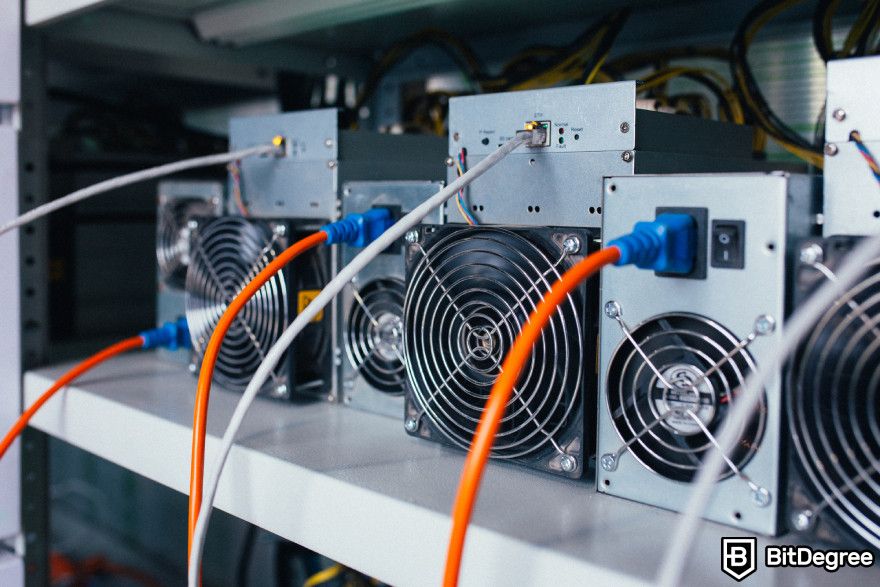
However, before starting mining, make sure your ASIC model is profitable, considering the current Bitcoin price and electricity costs.
Step 2: Register on EMCD.
Go to the EMCD app or website and create an account by providing a username, email, and a strong password.
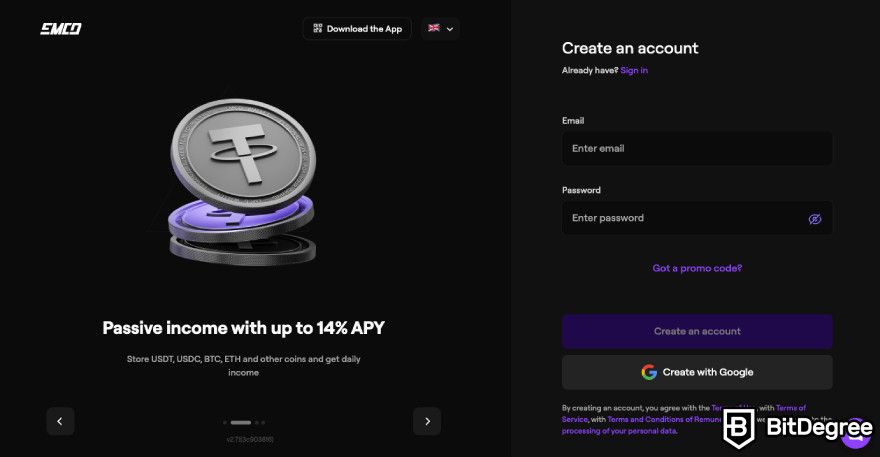
You’ll also have to confirm your email to activate your account.
Step 3: Add your Bitcoin wallet.
Once you create an account, log in and select [BTC] at the top-left corner of the mining tab (or any other crypto asset you want to mine).
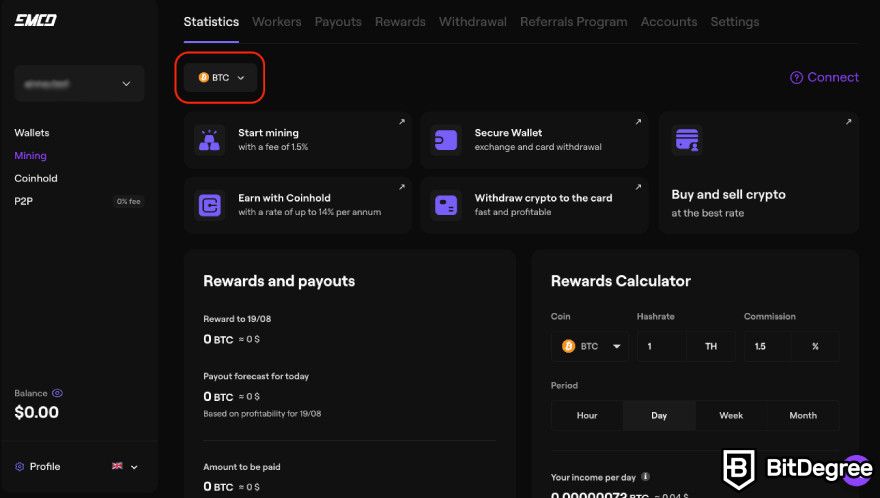
Then, click on the [Settings] button, add your Bitcoin wallet address, and confirm it via email. You can either use any external wallet or the EMCD Wallet.
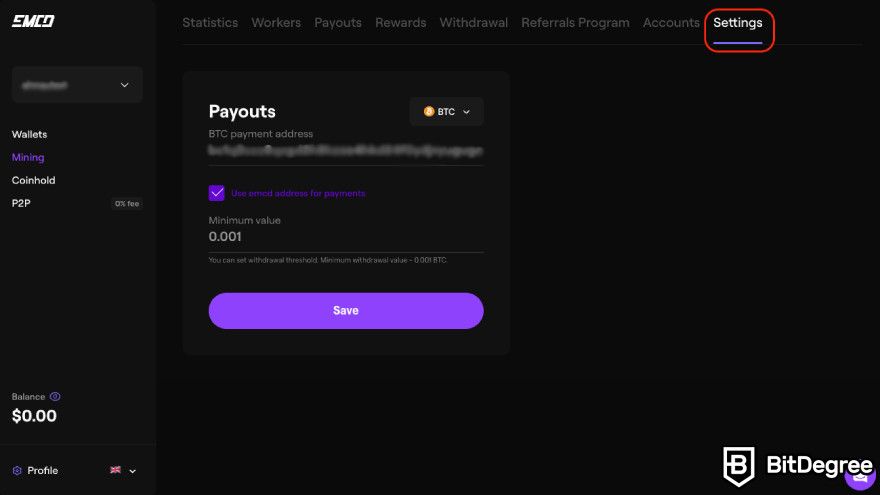
Step 4: Configure your ASIC miner.
Find your ASIC device's IP address using IP Scan or BTC Tools and enter it into your browser to access the ASIC's web panel.
Step 5: Connect to EMCD pool.
Go to the [Miner Configuration] tab in the ASIC web panel and add three stratum URLs for the regions closest to you:
- Russia: stratum+tcp://gate.emcd.io:3333
- Europe: stratum+tcp://eu.emcd.io:3333
- Kazakhstan: stratum+tcp://kz.emcd.io:3333
- China: stratum+tcp://cn.emcd.io:3333
- America: stratum+tcp://us.emcd.io:3333
- Iran: stratum+tcp://ir.emcd.io:3333
“3333” is the code of the pool coin, specifically Bitcoin. If you mine another coin, add another code there.
In the [Worker] field, enter your worker name in the format “your username.worker”. For example, if my user name was “bestcryptominer”, I would have to type in “bestcryptominer.worker”. In the [Password] field, just set a password (any password is fine).
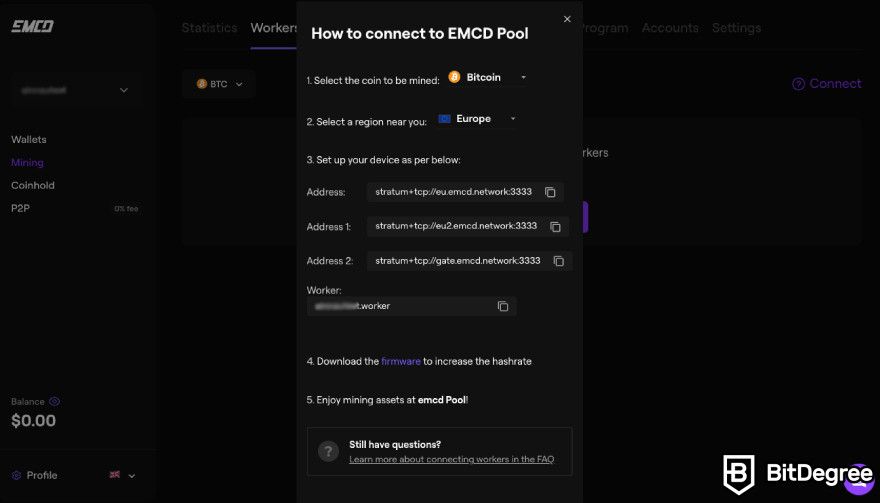
You can also find all this info in the [Workers] tab on your EMCD dashboard.
Step 6: Start mining.
Once everything is configured, your ASIC device will begin mining and sending shares to the EMCD pool. It takes about 15-20 minutes for the first data to appear in your EMCD account. After that, your device will be displayed on the EMCD website. That’s it!
How to Use Coinhold?
Now that you know how to start mining on EMCD, here’s a short guide on another popular feature I’ve discussed in this EMCD review - Coinhold.
Step 1: Access Coinhold.
If you want to access it via the website, log in to your EMCD account and find the [Coinhold] section in your dashboard.

If you’re using the mobile EMCD app, navigate to the [Wallets] section and select [Coinhold].
Step 2: Open a new Coinhold.
If you haven’t opened a Coinhold yet, go to the Coinhold section and create a new one.

You’ll have to choose the coins you want to grow, the period for which you want to lock your assets, and configure any other settings.
Step 3: Top up your Coinhold.
Ensure your wallet is funded with the desired coin. Then, top up your Coinhold directly through the Coinhold settings or from your EMCD wallet.
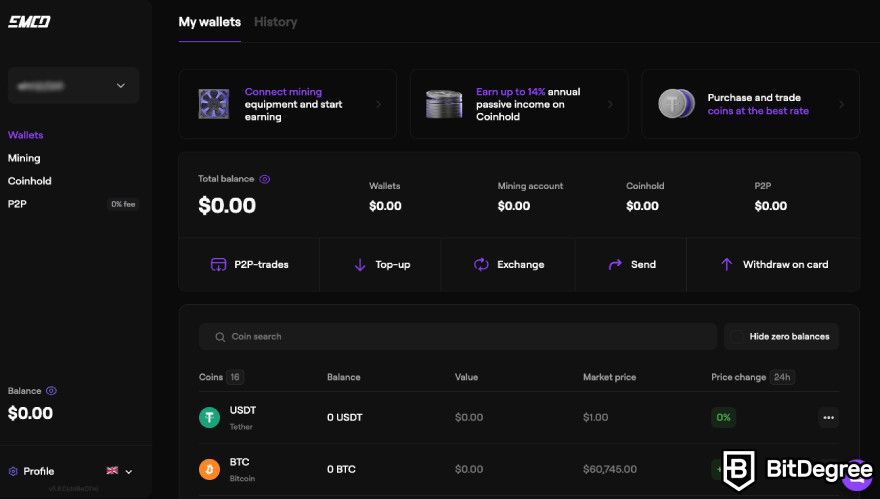
If you want to use the automatic top-up feature (only available for mining coins), go to the Coinhold settings and configure a daily automated deduction from your mining account. Just choose a percentage (1% to 100%) of your daily mining rewards you want to dedicate to Coinhold.
Step 4: Start earning.
After topping up, ensure your Coinhold balance remains unchanged for 24 hours. Interest will start accumulating after this period.
Step 5: Withdraw funds.
If you choose a fixed APY, you will not be able to withdraw funds before the period ends (30, 60, 180, or 360 days).
However, if you choose Coinhold options with partial withdrawal, you will be able to withdraw a portion of your funds while keeping the account open. The interest will be recalculated based on the remaining balance.
Also, with flexible APY, there is an option for early closure. As the name suggests, it allows you to close your Coinhold early, just note that any interest accumulated since the last capitalization will not be paid.
By following these steps, you can easily manage and grow your crypto with EMCD Coinhold.

- Secure and reliable
- Accepts fiat currencies
- Lots of trading options
- Reputable exchange
- Accepts fiat currencies
- Offers various trading options

- Fiat currencies - accepted
- Simple to use
- Accepts only the most trustworthy cryptocurrencies
- A leading cryptocurrency exchange platform
- Best for beginner investors
- Accepts fiat currencies

- Beginner-friendly
- Secure
- Decent trading and withdrawal fees
Conclusions
And there you have it - a complete EMCD review. Talking about its mining services, there’s a variety of mining pools for different assets with wide geographical coverage and low commissions. Plus, EMCD offers some handy extra features related to mining, like the custom firmware for Antminer devices.
Besides, even though EMCD pools are known to have relatively low hashrates compared to some bigger mining pools, the team behind the project works hard on improving their services.
Also, let’s not forget all the other features offered by EMCD, like its crypto wallet, P2P trading interface, and Coinhold. On top of all that, EMCD puts a huge emphasis on the security of your information and assets. Thus, if you’re looking for a mining platform that offers some cool features that are not only about mining, EMCD might just be the right choice for you.
The content published on this website is not aimed to give any kind of financial, investment, trading, or any other form of advice. BitDegree.org does not endorse or suggest you to buy, sell or hold any kind of cryptocurrency. Before making financial investment decisions, do consult your financial advisor.
Scientific References
1. D. Fantazzini, N. Kolodin: ‘Does the Hashrate Affect the Bitcoin Price?’;
2. A. Yaish, A. Zohar: ‘Pricing ASICs for Cryptocurrency Mining’.






